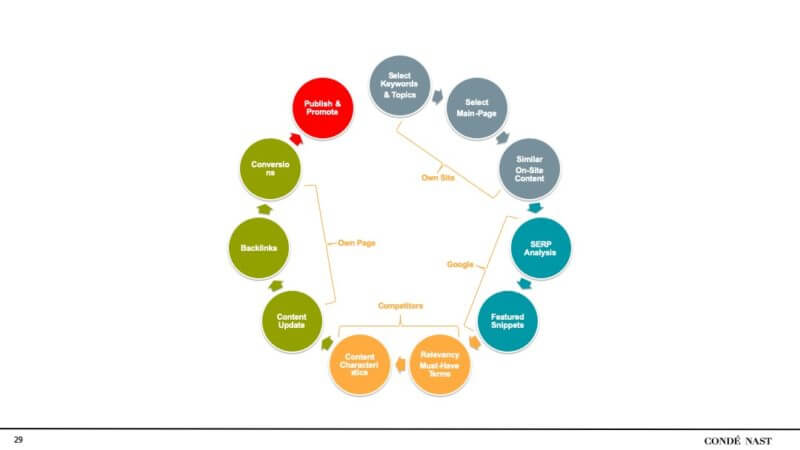Refreshing evergreen contents to acquire new traffic
We publish endlessly, convinced that relentlessly adding contents will automatically make our site’s organic traffic grow. That is what Ivano Di Biasi was saying in his unscheduled intervention at the SMXL Milan 2019, talking about seasonality and suggestions to intercept keyword seasonality with already existing resources, and Conde Nast case study provides us with useful cues for a strategic management of this aspect.
Condé Nast case study on contents revision
The topic has been the centerpiece of John Shehata ‘s intervention, vice president of the Condé Nast audience development strategy, during SMX East in New York in the past few weeks, as reported by Search Engine Land. The manager of the famous international editorial network explained that “investing in new content isn’t always the right choice for better content marketing“, because sometimes (or even often) brands can achieve better results by exploiting already existing resources and refreshing an old topic.
To publish new articles not always is the best strategy
This is the starting point of his considerations: the creation of contents can work miracles for your site, and we know how crucial quality is, but obviously they can never generate any kind of profit if not seen and ranked. A specific piece of data among all can picture the context: in the past two years a stunning 90% of online existing contents has been created, but still 91% of contents do not receive any traffic from Google.
How to work on already published contents and acquire new traffic
Based on these sorts of considerations, Condé Nast launched an experiment – called “Pinetree Initiative” – aimed to the revision of already published editorial contents and the merging of underperforming articles in order to increase organic visibility.
Results have been immediate and substantial: “For the first 100 articles that we optimized, we saw a 210% increase in search traffic and our keyword coverage for that content increased by 900%”, Shehata said. “Once we refreshed the content, the traffic started increasing immediately. It went from like 100 visits to like 15,000–20,000 visits”.
Giving new visibility to valuable evergreen contents
Keystone is to strategically work in order to give new visibility to evergreen contents, those long lasting ones that become ranking pillars on Google. Shehata presented the revision and updating process for evergreen articles he developed for Condé Nast: it begins by studying one’s personal site, then analyzing search result pages per target keyword, assessing competition’s contents, optimizing on page contents and lastly we come to publishing and advertising.
1. Evaluate your site’s existing contents
The update of evergreen contents begins from an analysis of the site, by identifying which pages are currently ranking for target keywords and if there are any internal competitions and keyword cannibalization problems.
The goal is to try and gather what of good there is within a single page: reinforce URLs, better manage internal links in order to supply a better topic overview, delete pages with poor performances or merge information to update a content and make it more authoritative or to create a more effective new evergreen article.
2. Study SERPs
“Last year, we had this amazing page about celebrity homes, and it wasn’t getting any traffic at all”, recounted Shehata as an example on the importance of aligning with search intent (and to reveal that big sites also have common problems!).
By analyzing SERPs, in fact, the team dicovered that other contents “ranked for that topic were all galleries”, and for that Google identified the “celebrity homes” search intent as people’s wish to see images of these homes. Condé Nast then “converted the page from an article format with a couple of images to a gallery with less content. And, guess what? The article immediately ranked number two”.
Lesson is that content’s characteristics are very important for the success fo the SEO, but that we also need to correctly picture the competition’s context: understanding what is the search engine rewarding on specific queries can give us an idea on how to structure our articles in order to increase their ranking chance.
To keep looking at the SERPs allows us to not only understand which content formats are better ranked, but to also keep track of all appearing rich results and why they do that: for instance, if there is a news carousel, does it mean that the topic is news-driven? And, if that is the case, how does that impact our article’s chance?
Featured snippets, that often terminate a user’s query directly on Google (more and more a competitor of all sites, as Rand Fishkin was also saying at SMX East), or the “People also ask” box provide us with all the information about questions people are asking on a specific topic, hence offering the opportunity to add more depth to evergreen contents.
3. Analyze competitors
Next step is to more specifically check competitors and analyze those better ranking on the SERP ones based on goal keywords: according to Shehata, “if you are writing about how to boil an egg, and all the other sites that are ranking mention eggshells, breakfast, and easy, you may want to consider these topics to give you complete and in-depth coverage of your topic”.
In a few words, we are basically talking about what SEOZoom instantly does with its intent gap and research of keyword with same search intent tools, allowing you to discover those topics our article should never miss out on. Furthermore, using tools for competitor analysis we can acquire an immediate picture not only of how the content already chosen by Google is currently displayed, but of its length, release date, use of headings and meta descriptions and other elements we can investigate for clues to understand why that content has ranked and how to replicate that success for our own.
4. Optimize onpage content
Once ended the step concerning the gathering of external information, the moment has come to tackle the actual work on our site’s content by expanding the original article with new information, merging a series of relevant contents and poorly performing ones or by directly deleting pages and setting the appropriate redirects.
According to Condé Nast’s experience, “when you refresh content, it should be at least 30% new”, as Shehata said, inviting to also change title, introduction, release date and to include new internal references toward new resources, obviously verifying that there are no errors on previous links.
5. Time to publish
Time factor can impact evergreen articles related to seasonal trends, as well, and in this case we need to plan our interventions and publish at least three months prior the anticipated spike in search volume in order to maximize our results.
According John Shehata, positive effects of the work of revision, optimization and update of contents can “last you at least a year, if not longer”: if traffic starts to substantially decrease, it could be time to perform another round of interventions, and the creation of an editorial calendar can further help us to better plan our future work.




